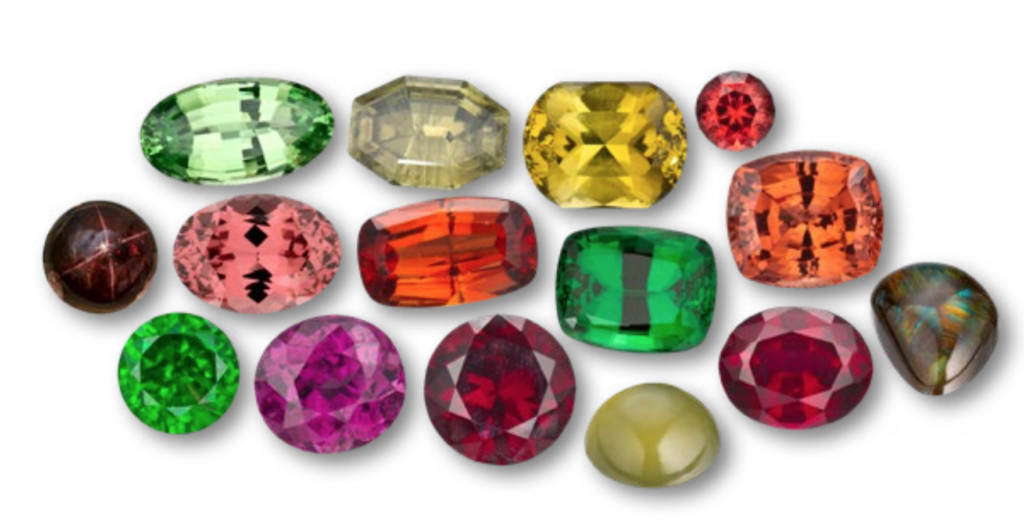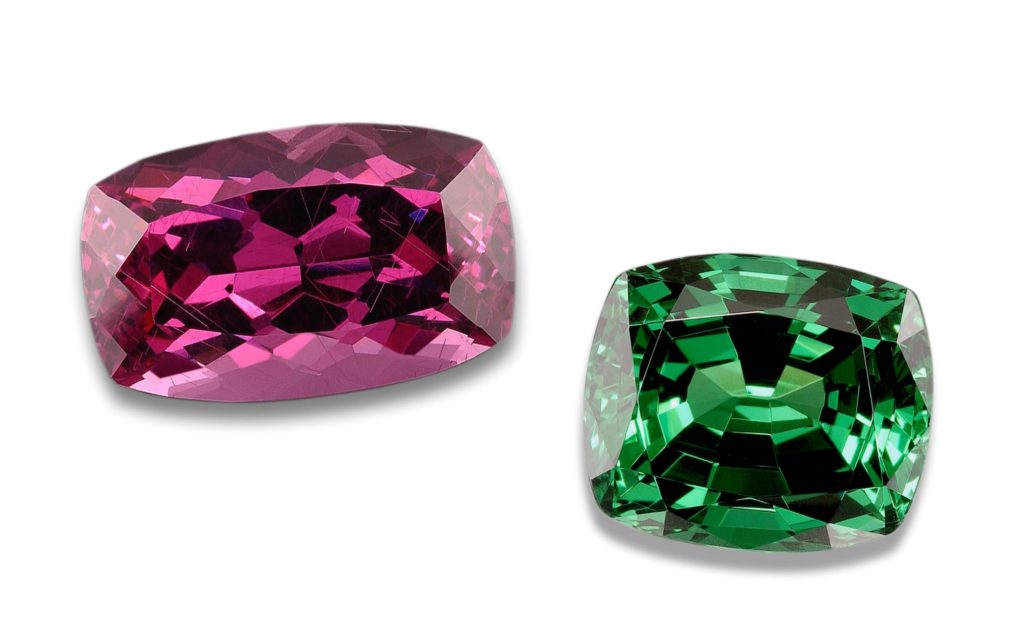Guide to Garnet

History, Lore and Appreciation
Several colorful gemstone species and varieties are members of the garnet group. The diversity of garnet – principally in color and appearance – places it among gemology’s most alluring subjects. These gems are found in variations of almost every hue and are linked to one another by their common crystal growth structure and basic chemical composition. However, the optical, physical and chemical properties of some garnet species and varieties overlap, making it difficult even for gemologists to pinpoint the distinct member of the garnet group.
Garnet has been appreciated for millennia. Historically, garnet was called “carbuncle,” a reference to hot, glowing coals, to describe its blazing red color. Most people think of garnet as red, and in fact the Latin derivation of the name reflects that. The phrase malum granatum refers to the striking resemblance some red garnet has to pomegranate seeds – especially rough garnet. Red garnet species include pyrope (from the Greek pyropos, meaning fiery) and almandine. Actually, most red garnet falls between pyrope and almandine in composition. For example, a violetish red variation is known in the trade as rhodolite.
Garnet occurs in deep yellow and fiery orange colors as well. Spessartine garnet (sometimes called spessartite in the trade) is named after the region of Spessart, Germany where it was first found. A spessartine garnet locality in Namibia produced a glowing orangey gem in the early 1990s that has come to be known as a “mandarin” garnet in the trade.
Demantoid, a variety of andradite garnet, is bright green, though andradite garnet can also be yellowish or brown in color. Demantoid derives its name from diamond, an allusion to the diamond-like luster of this garnet. Rich red chrome-pyrope garnets are often found in association with diamonds during the mining process. Consequently, diamond miners think of garnets as “indicator minerals” in their search for diamonds.
Grossular garnet is principally known through the brilliant green tsavorite garnet. Green grossular garnet was first found in the 1960’s in Tanzania, and later in Kenya not far from Tsavo National Park, after which it acquired its trade name. An orange grossular variety, hessonite, sometimes with a characteristic roiled internal appearance, was widely used in the past and often known in the trade as cinnamon stone, alluding to its color. Africa is the principal source of many garnets that are challenging to classify. Malaya garnet, is the trade name for a pinkish yellow, vivid orangey red variety of a mixture of pyrope-spessartine also found in the 1960’s in Tanzania, and later in Kenya and Madagascar.
Garnet also has interesting phenomenal varieties, namely four, six and twelve-rayed star garnets. In New Mexico (and in Mexico) a form of andradite garnet displays incredible iridescent colors in bright light, known in the trade as rainbow andradite. Some East African garnets display remarkable alexandrite-like, color-change characteristics. Similarly, some pyrope- spessartines change from grey or violetish blue in daylight, to deep, purplish red in incandescent light.
Birthstones and Anniversaries
Garnet is the birthstone for January. While consumers sometimes believe they are limited to only red garnet, it is clear they can choose many different colors. Garnet is the gem of choice for a 2nd wedding anniversary.

Description and Properties
Garnet belongs to a group of related silicate minerals that crystallize in the cubic crystal system. For specific properties of each species or variety, see garnet name below.
Treatments
Garnet is one of the few gems that is rarely treated to enhance its color or clarity. In rare instances, Russian demantoid (green andradite garnet) may be heated to enhance its color. This treatment involves low heat so as not to damage the collectible “horsetail” inclusions.
Collector Quality
Garnet has been used in jewelry since antiquity, especially as engraved gemstones, which are highly collectible. In red garnet, the size and pureness of color is highly desirable. Green garnet is almost always small – gems over 3 carats are considered rare and are therefore collectible. Demantoid often has signature “horsetail” inclusions composed of chrysotile fibers. Clever cutters will attempt to leave such inclusions in the center of the gem to exhibit a classic, collectible gem.
Cutting, Care and Cleaning
Garnet is generally somewhat susceptible to heat (and to some acids) so it is recommended that it be cleaned with a soft, non-abrasive, damp cloth. Garnet may abrade along facet junctions if scraped.
Almandine
Chemical Formula: Fe3Al2(SiO4)3
Color(s): Reddish orange to red, slightly purplish red to reddish purple; typically dark in tone
Refractive Index: 1.790 (±0.030)
Birefringence: None (singly refractive)
Specific Gravity: 4.05
Mohs Hardness: 7 to 7.5
Internal Identifying Characteristics: In almandine, tiny, oriented rutile needles may be seen in clusters. These sometimes are prevalent enough throughout the gem to cause a star effect (asterism). Other types of included crystals are also found.
Cause(s) of Color: Iron
Localities: India, Sri Lanka, Madagascar, Brazil, Greenland, Kenya, Pakistan, Tanzania, and the United States.
Andradite
Chemical Formula: Ca3Fe2(SiO4)3 Color(s): Yellow, green, brown, black
Refractive Index: 1.888 (+0.007, -0.033)
Birefringence: None (singly refractive)
Specific Gravity: 3.84
Mohs Hardness: 6.5 to 7
Cause(s) of Color: Iron and titanium (black); chromium (green), and in the case of demantoids from Namibia and Madagascar, lower concentrations of chromium and vanadium.
Localities: Italy, Korea, Russia (the classic source for demantoid), Iran, Madagascar, Pakistan, Namibia, Mexico and the United States (especially for the phenomenal iridescent variety).
Grossular
Chemical Formula: Ca3Al2(SiO4)3
Color(s): Light to dark green, light to dark yellow to reddish orange, colorless (rare); occasionally translucent to opaque pink (rosolite).
Refractive Index: 1.740 (+0.020, -0.010)
Birefringence: None (singly refractive)
Specific Gravity: 3.61 (+0.12, -0.04)
Mohs Hardness: 7 to 7.5
Cause(s) of Color: Iron or vanadium with a trace of chromium. In tsavorite, a mix of chromium, and vanadium (green).
Localities: Sri Lanka, Kenya, Tanzania, Ethiopia, Mali, Namibia, Myanmar, Brazil, Canada, India and the United States.
Hydrogrossular
Chemical Formula: Ca3Al2(SiO4)3-x(OH)4x Color(s): green to bluish green, pink, white, grey.
Refractive Index: 1.720 (+0.010, 0.050)
Birefringence: None (singly refractive)
Specific Gravity: 3.47 (+0.08, -0.032)
Mohs Hardness: 7.00
Cause(s) of Color: Chromium and possibly iron, manganese.
Localities: South Africa, New Zealand, Canada, the United States, Myanmar (Burma) and China.
Malaya
Chemical Formula: (Mg,Mn)3Al2(SiO4)3
Color(s): Light to dark, slightly pinkish orange, reddish orange, yellowish orange.
Refractive Index: 1.760 (+0.020, -0.018)
Birefringence: None (singly refractive)
Specific Gravity: 3.78 to 3.85
Mohs Hardness: 7 to 7.5
Localities: Tanzania, Kenya and Madagascar.
Pyrope
Chemical Formula: MgAl2(SiO4)3
Color(s): Medium to dark reddish orange, red through slightly purplish red, colorless (rare).
Refractive Index: 1.714 to over 1.742, 1.74 is normal
Birefringence: None (singly refractive)
Specific Gravity: 3.78 (+0.09, -0.16)
Mohs Hardness: 7 to 7.5
Internal Identifying Characteristics: In pyrope, tiny, oriented rutile needles may be seen in clusters. These sometimes are prevalent enough throughout the gem to cause a star effect (asterism). Other types of included crystals are also found.
Cause(s) of Color: Iron, chromium.
Localities: Australia, Czech Republic (the classic source in the 1700-1800s), South Africa, Brazil, Mozambique, Madagascar, and the United States.
Rhodolite
Chemical Formula: (Mg,Fe)3Al2(SiO4)3
Color(s): Light to dark purplish red through reddish purple.
Refractive Index: 1.760 (+0.010, -0.020)
Birefringence: None (singly refractive)
Specific Gravity: 3.84 (±0.10)
Mohs Hardness: 7 to 7.5
Internal Identifying Characteristics: In rhodolite, tiny, oriented rutile needles may be seen in clusters. These sometimes are prevalent enough throughout the gem to cause a star effect (asterism). Other types of included crystals are also found.
Cause(s) of Color: Iron.
Localities: Sri Lanka, Tanzania, Kenya, Madagascar, Mozambique, Ethiopia, India and the United States.
Spessartine
Chemical Formula: (Mn3Al2(SiO4)3
Color(s): Yellowish orange to reddish orange.
Refractive Index: 1.810 (+.004, -0.020)
Birefringence: None (singly refractive)
Specific Gravity: 4.15 (+ 0.05, -0.03)
Mohs Hardness: 7 to 7.5
Cause(s) of Color: Manganese and iron.
Localities: Brazil, Sri Lanka, Nigeria, Kenya, Tanzania, Australia, India, Madagascar, and the United States.
Source: CIBJO Retailers’ Reference Guide
